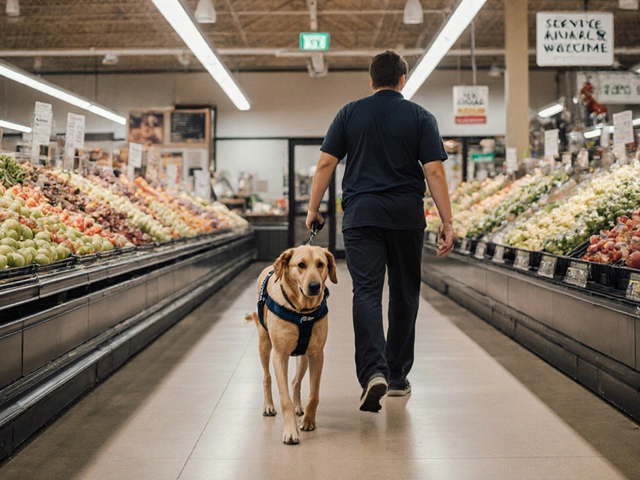Feeding your furry friend goes beyond simply filling their bowl. The number of meals a day can significantly impact their health and happiness. Whether you're a new dog owner or a seasoned enthusiast, understanding the best feeding schedule is crucial.
Different dogs need different feeding routines, affected by factors such as age, size, and lifestyle. Puppies, with their bounding energy and rapid growth, require a different approach than senior dogs conserving their energy. And just like in humans, a midday snack isn't a one-size-fits-all solution for dogs.
This piece aims to guide you through these complexities, offering insights and tips for a balanced canine diet. By the end, you'll be well-equipped to tailor your dog's meal times, keeping them both nourished and joyous.
- Understanding Your Dog's Nutritional Needs
- Age-Based Feeding Guidelines
- Factors Affecting Meal Frequency
- Practical Tips for Healthy Feeding
Understanding Your Dog's Nutritional Needs
Each dog has unique dietary requirements shaped by factors such as age, activity level, breed, and health status. Just like humans, dogs thrive best on a balanced diet that supplies essential nutrients, energy, and proteins. Knowing what your dog needs starts with understanding the main components of dog food: proteins, fats, carbohydrates, vitamins, and minerals. Proteins are the building blocks for muscles and tissues, fats provide a concentrated source of energy, and carbohydrates serve as an essential energy supply. Vitamins and minerals play crucial roles in various bodily functions, including maintaining the immune system and bone strength.
For young and energetic dogs, high-protein meals are vital since they are building muscle and growing rapidly. Larger breeds, on the other hand, may require diets lower in calories to avoid excessive weight gain and subsequent joint issues. Recognizing these nuances can prevent many potential health issues. According to a study published by the American Kennel Club, obese dogs are more likely to face health challenges, which underlines the importance of a proper diet.
Dogs aren't just eating machines; they have evolved digestive systems with specific functions that dictate their nutritional needs. Unlike their wild ancestors, who required high-fat diets from hunting and scavenging, domesticated dogs thrive on a variety of foods in moderate proportions. The modern dog needs more than just meat-based proteins; vegetables, grains, and fruits can also play a role in providing a balanced diet. The National Research Council states that dogs of different sizes and breeds have varied metabolic rates, meaning their dietary needs differ. This is one reason standard pet food alone may not meet every dog's nutritional requirements.
Feeding your dog involves considering several factors: their age, size, activity level, and even preferences. Puppies, for example, should consume more frequent meals to support their rapid growth, while adult dogs can often be fed twice daily. Dogs with higher activity levels might need a diet richer in fats and carbohydrates to maintain energy levels. On the other hand, senior dogs might benefit from high-fiber, low-calorie diets as their metabolism slows down. These considerations ensure that each feeding is not just filling a belly but also promoting a healthy and vibrant life.
"A balanced diet is crucial for a dog’s long-term health," says Dr. Julie Churchill, a veterinary nutritionist at the University of Minnesota. "Each morsel of food should not only satisfy hunger but also contribute to the dog’s holistic well-being."
Developing an understanding of these dietary elements is key to crafting a feeding plan that meets your dog's needs. Pet owners often focus on just filling the food bowl, but by paying attention to nutritional details and the specific requirements of their furry companions, they can enhance their dog’s quality of life. A well-balanced diet doesn’t just prevent fatigue and illness; it boosts the dog’s immunity and keeps its coat shiny and healthy. By prioritizing nutrition, you’re nurturing not just your dog’s body but also its spirit, enabling it to lead a life full of energy and happiness.

Age-Based Feeding Guidelines
When it comes to feeding your dog, age plays a pivotal role in determining just how much and how often you should offer meals. Puppies, for instance, are experiencing rapid growth and development, requiring more frequent feedings compared to fully grown dogs. For puppies, their nutritional needs are high, because they need essential nutrients to build healthy bones, muscles, and support their growing organs. Typically, puppies should be fed three to four times a day until they reach about six months of age. After this crucial growth phase, transitioning to fewer meals can begin.
Adult dogs, on the other hand, usually thrive with either two smaller meals or one large meal per day depending on their activity level, size, and breed. Diet plays a significant role in an adult dog’s energy and vitality. It's often recommended to split their daily ration into two meals, which helps in better digestion and managing hunger. Dr. Susan Lauten, a pet nutrition consultant, mentions, "Multiple smaller meals can aid in digestion and reduce the risk of life-threatening conditions such as gastric dilatation-volvulus, commonly known as bloat." This practice supports your pet's metabolism and helps maintain an optimal weight, especially for those breeds predisposed to weight gain, like Labradors or Beagles.
As dogs advance into their senior years, usually around seven years for small breeds and five years for large breeds, their metabolism tends to slow down, and so should their calorie consumption. Senior dogs might benefit from a diet that supports joint health and provides antioxidants for overall well-being. Adjusting the feeding frequency might not be as crucial as adjusting the portion size and nutritional content to suit their less active lifestyles. It's crucial to monitor your senior dog for signs of weight gain or loss, as both can indicate dietary adjustments are needed to support their changing health landscape.
To better understand these changes through a dog's lifespan, consider the table below highlighting the general guidelines for feeding frequency and needs based on age:
| Life Stage | Number of Meals | Comment |
|---|---|---|
| Puppy (0-6 months) | 3-4 meals daily | High energy and nutrient requirements |
| Adult (1-7 years) | 1-2 meals daily | Maintain weight and energy levels |
| Senior (7+ years) | 1-2 smaller meals | Focus on joint health and weight management |
Tailoring your dog's diet to their specific age can go a long way in ensuring they lead a healthy and vibrant life. As always, consulting with your veterinarian is a good practice for specific feeding guidelines suited to your dog’s unique needs.

Factors Affecting Meal Frequency
Finding the ideal number of meals for your dog involves weighing various factors that can influence their dietary needs. Key among these is your dog's age. Puppies, for instance, require more frequent meals to support their rapid growth and high energy levels. They typically benefit from around three to four meals throughout the day. In contrast, adult dogs often thrive on one to two well-portioned meals. Senior dogs, depending on their health, might need smaller, more frequent meals to aid digestion. This variation in dog feeding schedule is because a puppy’s metabolism and activity levels often outpace any other stage of life. Meanwhile, senior dogs may need adjustments to counter slower metabolism and potential health issues. Such differences highlight why understanding these distinctions is crucial for pet owners.
Breed and size also play pivotal roles. Larger breeds might require more food, yet less often, due to their muscular makeup and slower metabolism compared to smaller dogs. Small breeds might consume fewer calories in a single meal, needing more frequent feedings to maintain energy levels. Occasionally, veterinary experts recommend feeding prolonged intervals to larger breeds for specific health concerns, such as preventing bloat. According to the American Kennel Club, "Establishing a consistent feeding schedule from an early age not only keeps your dog healthy but also supports mental well-being, providing a sense of stability and routine."
Activity level is another significant consideration. A highly active working dog, such as a Border Collie involved in herding activities, may require more calories and a modified dog diet than a predominantly sedentary pet. Their energy needs may even warrant additional snacks or stick to meticulously portioned meals to maintain optimum performance and health. Conversely, dogs with minimal activity or those prone to gaining weight might need calorie-restricted diets, with fewer, carefully measured meals to prevent obesity. Developing a proper plan becomes paramount to match the energy output with meal input, ensuring your dog remains fit and energetic without risking nutritional deficits.
Other factors like medical conditions and individual health quirks also dictate how often your dog should eat. Conditions such as diabetes and gastrointestinal disorders might necessitate a specific dog meals regimen. It's critical to tailor feeding times to accommodate their unique requirements, often advised by veterinarians. An owner's lifestyle might impact pet nutrition as well. If you're someone with packed schedules, opting for automatic feeders might be a constructive approach to maintain a regular feeding pattern. Balancing these factors assists in crafting a feeding structure that promotes healthy living and satisfaction for both dog and owner alike.

Practical Tips for Healthy Feeding
When it comes to maintaining your *dog feeding schedule*, a few handy tips can make all the difference in ensuring your pet's well-being. One crucial aspect is consistency. Dogs are creatures of habit, so keeping their meal times consistent each day helps regulate their digestive system and can prevent unwanted behavioral issues linked to hunger. An erratic feeding schedule might confuse your furry friend, making them anxious and impacting their eating habits. Instead, fix specific times, ideally aligned with your household's routine, to establish a soothing rhythm in their daily life.
Portion control is another fundamental aspect of a balanced diet. Overfeeding might seem like a gesture of love, but it is essential to measure their food according to their nutritional requirements. Organs such as the liver and pancreas can be put under undue stress by improper feeding practices, potentially leading to long-term health problems. Many dog foods come with guidelines based on weight and age, but these are only starting points. Observing your pet and adjusting quantities as necessary is just as important. Consult your vet to tailor the exact diet plan that best suits your dog's size and activity levels, preventing issues related to both obesity and malnourishment.
Introducing variety into your dog's diet can be beneficial, both in terms of meeting pet nutrition requirements and keeping meal times exciting. Dogs have different tastes just like humans, and mixing different types of meats, vegetables, and grains can improve their diet palatability. However, do this gradually to allow your pet to adapt to new flavors and avoid upsetting their stomachs. Some sources even suggest a mix of commercial and homemade meals to balance between taste and nutritional content. But always steer clear of foods toxic to dogs, such as chocolate and onions, which can cause severe reactions.
Another point to consider is hydration. Make sure your dog always has access to fresh water throughout the day, especially if you're feeding them dry food. Dogs tend to drink less water in their bowls than they need if eating only dry food, risking dehydration, particularly in active or large breeds. Encourage regular water intake as part of their feeding routine, and pay attention to signs of dehydration such as dry gums or excessive panting. It might be wise to add some wet food or broth to their diet to boost water consumption naturally.
Monitor your dog's weight and health regularly. Keep track of any unusual weight gain or loss, and any changes in their eating habits as these could indicate health issues. Periodic check-ups with your vet ensure you have expert insights on your dog’s ongoing dietary needs and adjustments. Establishing a good relationship with your vet can also provide peace of mind, allowing you to focus on giving your dog a happy and healthy life.
For those contemplating professional input, Dr. Emily Ryan, a renowned veterinary nutritionist, states, "A well-fed dog is a happy and energetic companion. The right balance and timing in feeding can prevent numerous health issues down the line, emphasizing how pivotal nutrition is to longevity and quality of life." Maintaining your pet’s *dog meals* strategically tailored to their needs ensures their long-term well-being and your shared enjoyment.





